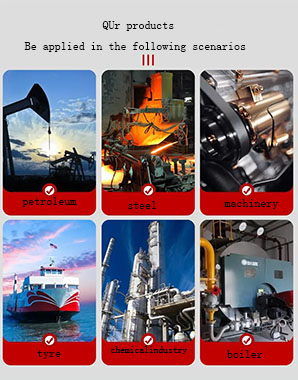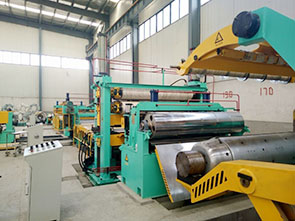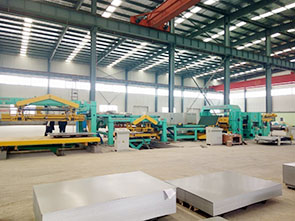Uncoiler: Used to carry and unroll metal coil plates, providing raw materials for subsequent processing. Commonly used ones include hydraulic expansion and contraction type uncoilers and mechanical expansion and contraction type uncoilers, which can adapt to coil materials with different inner diameters and weights.
Guiding Device: Guides metal sheets to accurately enter the slitting machine, ensuring the running direction and position accuracy of the sheets, reducing the phenomenon of deviation, and improving the processing quality.
Uncoiling Tension Device: By applying appropriate tension, it keeps the metal sheets flat and stable during the uncoiling process, preventing wrinkles or slack, and providing favorable conditions for subsequent shearing processing.
Crop Shear: Used to cut off the irregular parts at the head of the metal coil, making the front end of the sheet neat, facilitating subsequent threading and processing.
Threading Table: Facilitates operators to introduce metal sheets into the slitting machine, ensuring that the sheets can smoothly enter the shearing area.
Looper: According to its installation position, it can be divided into single-entry looper, single-exit looper, and double-looper. The function of the looper is to store a certain length of metal sheets, realizing micro-tension or zero-tension shearing, avoiding slippage of the shearing blades, and also playing a buffering and regulating role to ensure the continuity and stability of production.
Rotary Shear: It is one of the core components of the slitting line. It longitudinally shears metal sheets by rotating disc blades, cutting them into narrow strips with the required widths. The blades of the rotary shear are usually made of high-quality alloy tool steel, having high hardness and wear resistance to ensure the shearing quality and service life.
Guiding Roll: After the metal sheets are longitudinally sheared, the guiding roll is used to guide the cut narrow strips to continue moving forward, maintaining their running direction and position accuracy, ensuring that the narrow strips can accurately enter the coiler for recoiling.
Train Transfer Roll: Responsible for transferring metal sheets between various equipments, enabling the sheets to smoothly complete a series of processes such as uncoiling, longitudinal shearing, and recoiling, ensuring the continuity of the production process.
Inlet Clamping Device: Before the metal sheets enter the slitting machine, it clamps and fixes them to prevent displacement or shaking of the sheets during the shearing process, improving the shearing accuracy.
Constant Tension Coiling Device: During the recoiling process, in order to ensure the coiling quality and make the coiled strips tight and neat, the constant tension coiling device will apply a constant tension to the strips, and simultaneously adjust the tension magnitude automatically according to the change of the coil diameter to ensure the recoiling effect.
Scrap Chopper: Used to crush the waste strips generated during the longitudinal shearing process, facilitating recycling and transportation, and reducing the space occupied by waste materials.
Waste Cart: Collects and stores the waste materials crushed by the scrap chopper, facilitating regular cleaning and transportation.
Coiler: Re-coils the narrow metal strips after longitudinal shearing into coils for convenient storage and subsequent use. The coiling speed and tension of the coiler can be adjusted according to different technological requirements to ensure the coiling quality.
Lining Paper Device: During the coiling process, the lining paper device will insert a layer of lining paper between the metal strip and the coiler drum to prevent the strip from directly contacting the drum, avoiding scratches on the surface of the strip, and also facilitating the unloading and use of the strip.
Technical Parameters
Processing Materials: Applicable to cold-rolled and hot-rolled carbon steel, silicon steel, tinplate, stainless steel, and various metal materials after surface coating, such as common galvanized sheets, aluminum sheets, copper sheets, etc.
Raw Material Sheet Thickness: Generally, thin-sheet slitting lines can process sheets with a thickness of 0.1 - 3.0 mm, and thick-sheet slitting lines can process sheets with a thickness of 3.0 - 6.0 mm.
Raw Material Sheet Width: The common sheet width range is 500 - 1800 mm, but there are also wider or narrower specifications that can be customized according to user requirements.
Coil Inner Diameter: Usually common specifications such as φ508 mm or φ610 mm.
Coil Outer Diameter: Generally not exceeding φ1600 mm, and the specific size depends on the model and specification of the equipment.
Maximum Coil Weight: The maximum coil weight that different models of slitting line equipment can carry varies, and the common one is about 10,000 kg.
Number of Longitudinal Shears: According to the difference in sheet thickness and equipment configuration, the number of longitudinal shears also varies. For example, when the thickness is 3 mm, the number of longitudinal shears can reach 7; when the thickness is 1 mm, the number of longitudinal shears can reach 25; when the thickness is less than 0.5 mm, the number of longitudinal shears can reach 55.
Longitudinal Shearing Speed: Generally, the maximum longitudinal shearing speed of slitting lines is between 150 m/min - 200 m/min, but the speed of some equipment may be higher or lower, depending on the performance and processing requirements of the equipment.
Inner Diameter of Finished Strip: Usually the same as the inner diameter of the raw material coil, which is common specifications such as φ508 mm or φ610 mm.
Outer Diameter of Finished Strip: Generally not exceeding φ1600 mm, and the specific size depends on factors such as the width and thickness of the coiled strip.
Maximum Recoiling Weight: Similar to the maximum coil weight, the common maximum recoiling weight is about 10,000 kg.
Minimum Strip Width: For the case where the sheet thickness is less than or equal to 0.5 mm, the minimum strip width can be as low as 15 mm.
Width Accuracy: When the sheet thickness is less than or equal to 1 mm, the width accuracy can reach ±0.05 mm; when the sheet thickness is greater than 1.1 mm, the width accuracy can reach ±0.1 mm.
Shearing Burr: Generally, the shearing burr is required to be controlled within 5% of the sheet thickness, and the minimum can reach 0.03 mm.
Straightness of Strip: For standard high-quality sheets with a width greater than 100 mm, the straightness of the strip can reach 0.5 mm/1000 mm.
Equipment Types
According to the Material Longitudinal Shearing Sheet Thickness: It can be divided into thin-sheet slitting lines and thick-sheet slitting lines. The thin-sheet slitting lines process sheets with a thickness of 0.1 - 3.0 mm, and the thick-sheet slitting lines process sheets with a thickness of 3.0 - 6.0 mm.
According to the Longitudinal Shearing Metal Material: It includes copper strip slitting lines, stainless steel slitting lines, cold plate slitting lines, silicon steel slitting lines, tinplate slitting lines, etc.
According to the Degree of Automation: It can be divided into fully automatic slitting lines and semi-automatic slitting lines. The fully automatic slitting lines adopt advanced automation control systems to realize fully automated operations from uncoiling, feeding, shearing to recoiling, reducing manual intervention, improving production efficiency and product quality; the semi-automatic slitting lines require some manual operation cooperation, and the degree of automation is relatively low.


The main business scope of Jinan Jieheng Machinery Equipment includes: decoiling, leveling and transverse shearing lines, decoiling, slitting and winding lines, flying shearing lines, decoiling and oscillating shearing production lines, belt tensioners, decoiling and pressure blanking lines, high-speed feeding and laser blanking lines, etc. It also undertakes technical service work such as maintenance and repair of decoiling equipment, provision of spare parts, purchasing second-hand decoiling line equipment on behalf of customers, equipment relocation and renovation, and equipment upgrading.

The company's service philosophy is to focus on quality, seek development with integrity, provide customers with products of high cost performance and high-quality and efficient services, and establish long-term partnerships with mutual trust and mutual benefit with customers.








